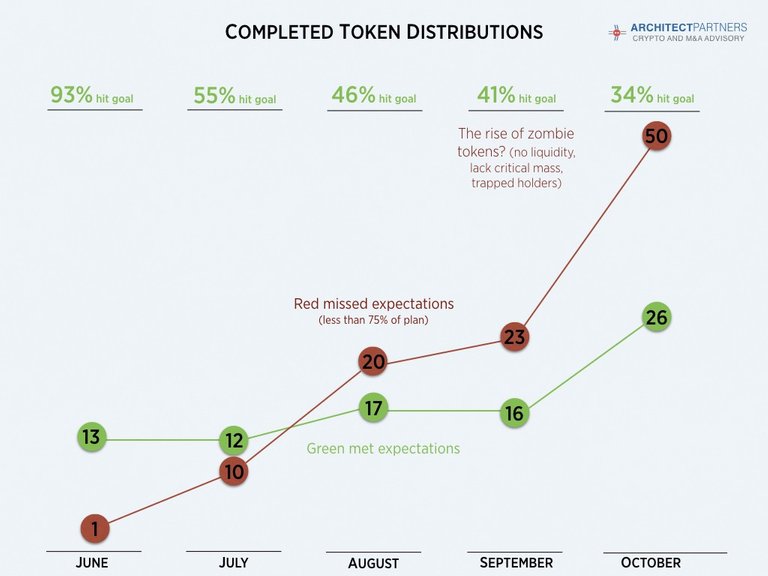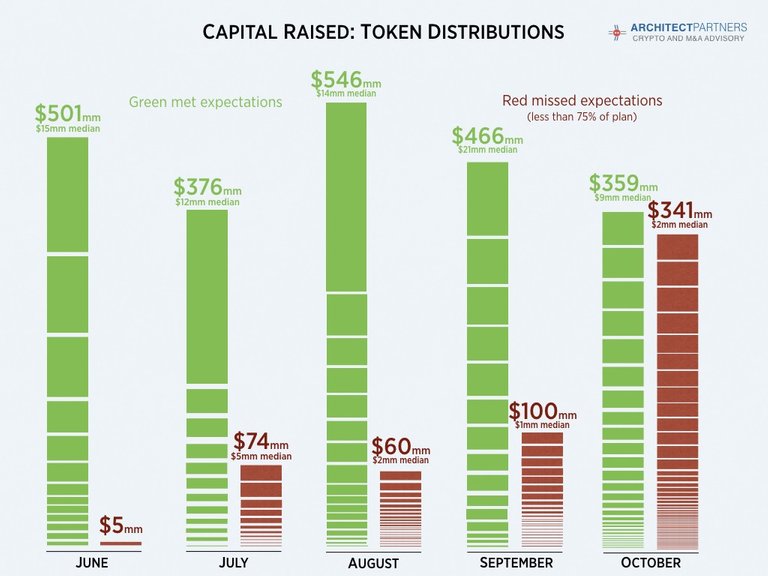Updated ICO Market Condition Observations
One month ago we published Most ICOs Fail: Tale of Two Worlds which looked beyond the breathless, positive headlines to better understand, on a project by project basis, the important nuances of the ICO market. That data betrayed an increasingly challenging market. The real story was that an increasing number of ICOs failed to achieve their funding objectives, often quite dramatically.
Update: What Happened Over the Past Month?
The headline remains very positive. In October 2017, 76 projects completed their ICO raising the equivalent of $700mm, a record month. However, as we observed last month, the market is becoming more selective with only 26 projects, 34% of the total, a new low, hitting their funding objectives. In addition, we believe there are at least a couple of dozen projects who have announced the launch of an ICO, yet have since gone silent publicly. These findings are consistent with the anecdotal signals we experience daily.

Criticism of Our Conclusions
Our analysis and conclusions are based upon comparing publicly announced funding objectives with actual capital raised. Our measure of success is the arbitrarily selected hurdle of raising 75% of the stated objective. This approach has been fairly criticized; arguing that raising funding at all via an ICO, regardless of amount, constitutes success. In some cases, I’d wholeheartedly agree, particularly in a situation where the team had an ambitious funding goal, fell short, but still raised tens of millions in capital.
The Coming Era of Zombie Tokens?
However, many projects have only raised modest amounts of capital via their ICOs. As an example, since June 2017 we count 82 projects which have raised $5mm or less, often far less.
This creates a conundrum. Medium to long term, token value is fundamentally dependent upon i) token use within a “viable, live and sustainable” project and ii) token holder liquidity. The limited capital raised may increase the risk of getting to a viable project state and the small number of tokens issued virtually guarantees lack of liquidity. Unfortunately, we fear the combination may result in many “Zombie Tokens”.
We define Zombie Tokens as ones which i) lack critical mass of users/supporters, ii) lack sufficient funding to achieve the vision described in their white papers, iii) lack token holder liquidity and iv) will likely find it very difficult to raise additional capital in the future due to i) through iii). Further complicating this scenario, issuers often have fixed the token supply in perpetuity, possibly prohibiting future sales of additional tokens to raise needed capital.
Zombie Tokens are very different than outright failed projects. Zombie Tokens may actually contribute to project failure by i) signaling a limited number of supporters, ii) making it difficult to attract exchange listings and, if attracted, virtually guarantee inefficient price discovery and liquidity due to low volume, iii) create frustrated token holders who are constantly sniping. All of these factors distract and can create a negative feedback cycle.
It’s easy to be critical. That’s not our intent. Our objective is to assist the crypto / blockchain community to create a robust yet rational, sustainable, legally and regulatory compliant marketplace for crypto currencies and tokens. We’ve been direct participants in past eras of irrational exuberance and believe, as well stated by Carlota Perez in Technological Revolutions and Financial Capital, that such a state is a precursor to “great technological surges of development.” However, the immediate aftermath can be painful.
Suggestions for Consideration
We are crypto / blockchain believers but recognize that the market will suffer growing pains, some of which are beginning to manifest today. For those seeking to use tokens as a funding vehicle or as an in-platform incentive mechanism, we’d suggest considering the following:
Prepare carefully, assume a challenging market reception with tough questions and increasingly higher purchaser expectations.
Assume that you will need to engage with the growing number of professional crypto purchasers to successfully complete an ICO.
Assume the regulators will regulate eventually, in some manner. Take steps to mitigate current and prospective risks.
Build in flexibility to adapt to the future unknown. For example, be cautious about pre-determining all token terms. Adaptation for platform use case or additional capital may be advantageous.
Open Source Backup Materials
For those interested, here is the Google Spreadsheet for all our data analytics. We intend to allow for commenting, editing and corrections.
On a final note, we are aware of the ongoing debate on the proper words to use to describe what has become colloquially known as an ICO or Initial Coin Offering. We prefer Token Distribution, others have gelled around TGE or Token Generation Event. Regardless, it’s form over substance in our mind. The regulators are not going to be influenced by the name used to describe this type of transaction. We’ve stuck with ICO in this article as it’s the most commonly used and widely understood term.

Eric Risley
Hi! I am a robot. I just upvoted you! I found similar content that readers might be interested in:
https://medium.com/@ericrisley_83384/the-coming-era-of-the-zombie-token-707350b34b42